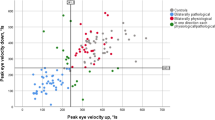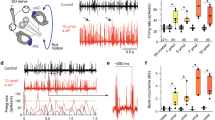Abstract
In twoMacaca rhesus monkeys that received repeated N-methyl-4-phenyl-1,2,3,6-tetrahydropyridine (MPTP) injections (single dose 0.2 mg/kg, i.m.; cumulative dose 11.2–13.3 mg), changes in characteristics of spontaneous saccadic eye movements and vestibulo-ocular reflex (VOR) were evaluated. With the development of severe behavioral disturbances, amplitude of spontaneous saccadic eye movements gradually decreased. Pronounced changes in duration of saccadic eye movements, frequency of spontaneous saccades, and their pattern were observed. No changes in parameters of VOR slow component were recorded, but high total MPTP doses suppressed fast phase of the reflex.
Similar content being viewed by others
References
M. Ya. Voloshin, “Experimental reproduction of catecholamine-depleted states and Parkinsonism (theoretical and practical aspects),”Neirofiziologiya,22, No. 3, 401–414 (1990).
B. R. Bloem, I. Irwin, O. J. S. Buruma, et al., “MPTR model: Versatile contributions to the treatment of idiopathic Parkinson's disease,”J. Neurol. Sci.,97, No. 2/3, 273–293 (1990).
R. S. Burns, C. C. Chieueh, S. P. Markey, et al., “A primate model of Parkinsonism: Selective distribution of dopaminergic neurons in the pars compacta of the substantia nigra by MPTP,”Proc. Natl. Acad. Sci. USA.,80, 4546–4550 (1983).
G. C. David, A. C. Williams, S. P. Markey, et al., “Cronic Parkinsonism secondary to intravenous injection of a meperidine analogue,”Psychiatr. Res.,1, No. 2, 249–254 (1979).
J. D. Elsworth, A. Y. Deutch, D. E. Redmond, et al., “MPTP-induced Parkinsonism: Relative changes in dopamine concentration in subregions of substantia nigra, ventral tegmental area, and retrorubral field of symptomatic and asymptomatic vervet monkeys,”Brain Res.,513, No. 3, 320–324 (1990).
B. A. Brooks, A. F. Fuchs, and D. Finocchio, “Saccadic eye movement deficits in the MPTP monkey model of Parkinson's disease,”Brain Res.,387, No. 3, 402–407 (1986).
W. Schultz, R. Romo, E. Scarnati, et al., “Saccadic reaction times, eye-arm coordination, and spontaneous eye movements in normal and MPTP-treated monkeys,”Brain Res.,78, No. 2, 253–267 (1989).
J. A. Sharpe, “Ocular motore deficits in Parkinson's disease,”Brain Res.,111, No. 1, 115–129 (1988).
B. Fischer, “The preparation of visually guided saccades,”Rev. Physiol., Biochem. Pharmacol.,106, No. 1, 1–35 (1987).
D. A. Robinson, “Control of eye movements,” in:Handbook of Physiology, Maryland, Am. Physiol. Soc., Bethesda (1981), pp. 1277–1320.
G. R. Barnes, “Head-eye coordination in normals and in patients with vestibular disorders,”Abv. Oto-Rhino-Laryngol.,25, No. 1, 197–201 (1979).
B. Cohen, D. Helwig, and T. Raphan, “Baclofen and velocity storage: A model of the drug on the vestibulo-ocular reflex in the rhesus monkey,”J. Physiol.,393, 703–725 (1992).
L. C. Evinger, A. F. Fuchs, and R. Baker, “Bilateral lesions of the medial longitudinal fasciculus in monkeys: Effects on the horizontal and vertical components of voluntary and vestibular-induced eye movements,”Exp. Brain Res.,28, No. 1, 1–20 (1977).
R. A. McCrea, A. Stressman, E. May, and S. M. Highstein, “Anatomical and physiological characteristics of vestibular neurons mediated the horizontal vestibulo-ocular reflex of the squirrel monkey,”J. Comp. Neurol.,264, No. 3, 547–570 (1987).
Yu. V. Burov, S. E. Metkalova, A. É. Kustov, et al., “Effect of amiridine on MPTP-induced Parkinsonian-like syndrome in monkeys,”Byull. Éksp. Biol. Med.,62, No. 11, 495–197 (1992).
D. A. A. Robinson, “A method of measuring eye movements using a scleral search coil in a magnetic field,”IEEE Trans Biomed. Eng.,10, No. 1, 137–145 (1963).
B. M. Sheliga, S. K. Prokof'ev, V. V. Shul'govsky, and A. A. Moskvitin, “Simple technique for implanting a wire coil in the cat eyeball,”Fiziol. Zh. SSSR,73, No. 1, 133–134 (1987).
B. M. Sheliga, V. V. Shul'govsky, S. K. Prokof'ev, et al., “The ‘efferent copy’ hypothesis in saccadic programming in cats,”Neirofiziologiya,20, No. 5, 631–637 (1988).
É. M. Kandel',Parkinsonism and Its Surgial Cure [in Russian], Meditsina, Moscow (1965).
F. Lestienne and P. Caillier, “Role of the monkey substantia nigra pars reticulata in the orienting behavior and visually triggered arm movements,”Neurosci. Lett., No. 1, 109–115 (1986).
E. Godaux and J. M. Laune, “The saccadic system and the vestibulo-oscular reflex in the cat do not share the same integrator,”Neurosci. Lett.,38, No. 2, 263–268 (1983).
Author information
Authors and Affiliations
Additional information
Neirofiziologiya/Neurophysiology, Vol. 25, No. 3, pp. 184–190, May–June, 1993.
Rights and permissions
About this article
Cite this article
Burov, Y.V., Metkalova, S.E., Kustov, A.É. et al. Oculomotor activities in monkeys with N-methyl-4-phenyl-1,2,3,6-tetrahydropyridine-induced syndrome of parkinsonism. Neurophysiology 25, 156–160 (1993). https://doi.org/10.1007/BF01053143
Received:
Issue Date:
DOI: https://doi.org/10.1007/BF01053143




